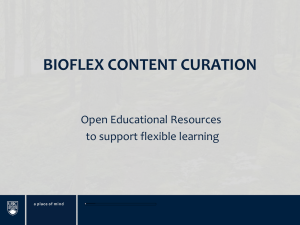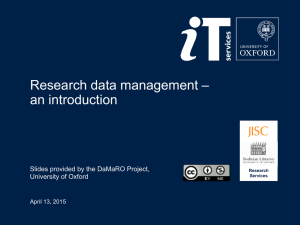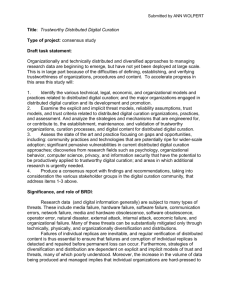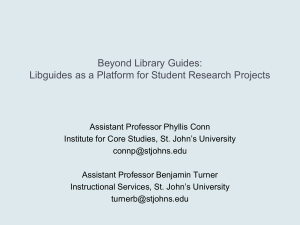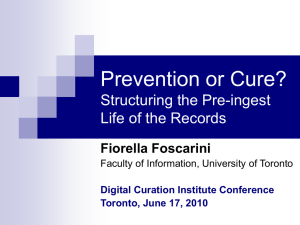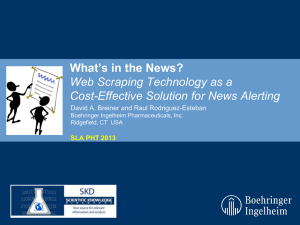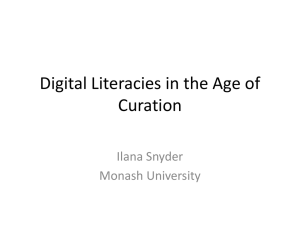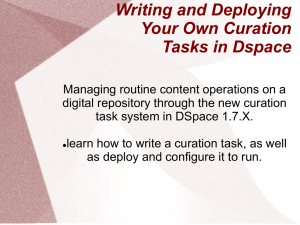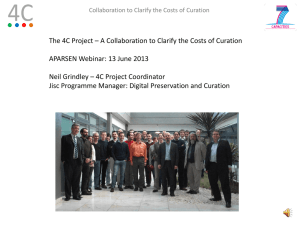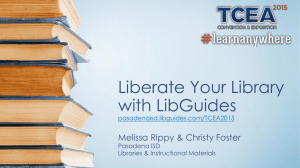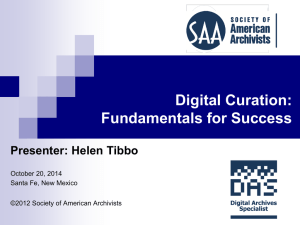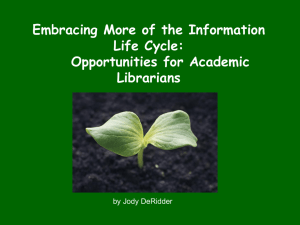Digital Collection Development: “Curating” Content
advertisement
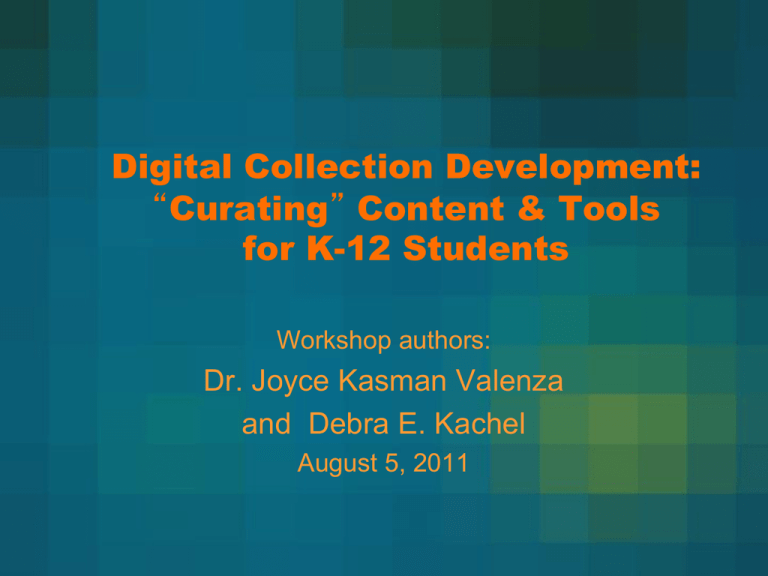
Digital Collection Development: “Curating” Content & Tools for K-12 Students Workshop authors: Dr. Joyce Kasman Valenza and Debra E. Kachel August 5, 2011 This workshop was made possible with funds from: The Pennsylvania Department of Education Commonwealth Libraries Bureau of Library Development Library Services & Technology Act (LSTA) Funds August 2011 WebJunction Pennsylvania, a service of ACCESS Pennsylvania, will be used to archive and store resources and links for this workshop. http://pa.webjunction.org/1 WJPA provides an online learning community for librarians to share ideas, news, and engage in online courses and other professional development. A free, user-created login is required. NOTE: All materials for this workshop are also included in the Digital Collection Curation Workshop LibGuide at http://palibraries.libguides.com/curation. Workshop Overview Collection development in the digital environment places the librarian in the role of “curator”– selecting, organizing, and presenting both digital content and tools so that students and patrons can access them anywhere & anytime. This workshop will teach librarians how to create online guides or “pathfinders” to the resources they select to meet the needs of library users. Workshop Objectives Participants will: 1. Embrace an expanded concept of “collection” to include digital content and tools, 2. Apply collection development strategies to digital resources, 3. Recognize the library user as selector, collaborator, and information producer, 4. Learn to use some basic types of digital tools appropriate for K-12 students, 5. Create a digital guide or pathfinder with LibGuides, selecting traditional resources and digital content & tools. Defining a library “collection” Group of resources or information made physically available or electronically accessible to the library’s user Selected or collected by a librarian or in collaboration with teachers, students, and others, including experts Based on selection criteria or a collection development policy to meet the needs of the institution and its users From Empowering Learners, the AASL guidelines • “The school library media program includes flexible and equitable access to physical and virtual collections of resources that support the school curriculum and meet the diverse needs of all learners (33).” • One of the ACTIONS for the school librarian: “Designs and maintains a library website that provides 24/7 access to digital information sources, instructional interventions, reference services, links to other libraries and academic sites, information for parents, and exhibits of exemplary student work (34).” Expanding our definition of library “resources” PRINT - books, periodicals, etc. DIGITAL/ELECTRONIC – AV, websites and web-based tools, software, ebooks, licensed databases, etc. EQUIPMENT/DEVICES - flip cameras, audio recorders, laptops and other mobile computing devices needed to view, listen, watch, record, or produce information OTHER –community resources (museum, arboretum, etc.), student work, experts, or services like ILL and distance learning courses Let’s talk about Websites Content-based • Examples: NASA, PBS, International Children’s Digital Library POWER Library databases • Can be free or licensed • Constantly updated info on specific subjects • Selected to meet the school’s curriculum/ library’s mission Tool or Application Based • Examples: Animoto, Glogster, Jing, wikispaces • Can be free or licensed • New features can be added in updates • Selected as learning tools for students to organize or communicate content NOTE: Check out the web tools at AASL’s Best Websites for Teaching and Learning. What is Digital Collection Curation? The selection and assembly of a focused group of resources into a single, web-based presentation that meets an identified purpose or need and has meaning for a specific audience. Resources, while mostly web sites and tools, can include traditional library resources, as well as customized instruction and recommended “people & places” relevant to the topic. What’s the difference from traditional collection development? Traditional library “collecting” implies organizing a collection of resources for lots of users for multiple purposes. Curating is much more targeted and highly selective, often telling a “story” much like a museum curator does in the staging of a collection. Curation is a shared environment in which librarians and others verify and add resources to existing collections; involves building and aggregating (“mashup” or “remix”); using others work (with permission) Collection Development • Mostly print, physical collection • Fairly static collection (money an issue) • General- for many users with many purposes • Developed by one institution for one institution • Institution access and use (in-library usage or visit required to borrow) Digital Collection Curation • Mostly electronic, virtual collection • Fluid, constantly updated (money not necessarily an issue) • Focused topics or purposes for a specific audience • Developed by many for many • Global access and use, beyond the local library (think wikipedia) Why curation? “Curation comes up when search stops working. But it’s more than a human-powered filter. Curation comes up when people realize that it isn’t just about information seeking, it’s also about synchronizing a community. Part of the reason that human curation is so critical is simply the vast number of people who are now making and sharing media. Everyone is a media outlet.” Blogger, author, and NYU professor Clay Shirky, quoted in Mashable http://mashable.com/2010/05/03/content-curation-creation/ Yes, we are blowing the doors off the library! It’s time! The Collection Development Process Needs Assessment Traditional Print World Digital World • What is the library’s mission? • Who are our library users? • – Demographics – Reading levels – Languages spoken • What are the needs of our library users? – Curriculum – Personal interests What else is important? Collection Assessment Digital World • Traditional Print World • Current collection • Usage data • Growth rates • Collection goals Does use of print resources predict use of digital resources? • Can usage statistics of digital resources be collected and useful? • Who does collection assessment? • Other issues Selection Traditional Print World • Universe of resources-where and how do you find available titles? Review sources? • Policies & procedures – • Selection criteria, subjects collected, languages, formats, multiple copies, intellectual freedom, gifts, lending policies, ILL, etc. Weeding Digital World •What digital resources should be collected? •Who selects? •Do they “age”? Acquisition How is “acquiring” digital resources different than print resources? • Costs? • Access? • Filtering? Be sure that you recognize and use “creative commons” licenses http://creativecommons.org/licenses/ Organization & Presentation What needs to be considered when making digital content & tools available to students, teachers, and library patrons? Especially when accessed outside the library. For example, compare these two: IPL2 for Teens: Work & Money and Only2Clicks versions. Here’s why you are learning how to use LibGuides “... My advice to librarians who are going through some sort of transition or downsizing is to step up their web presence. You can’t easily get rid of what you see. The more visible librarians are in their community or school or district, the less likely that they’ll be taken away. Those teacher librarians who are hiding their brilliant programs under a bushel, that’s when they’re most likely to get cut because their program is not visible to the community. When libraries get cut, people say, “So what are they doing? They’re just checking out books.” That’s what we have to fight – that perception!” Gwyneth Anne Jones Source: Strauss, Valerie. “What is Literacy Today? The Daring Librarian Explains.” Washington Post-Answer Sheet blog. July 22, 2011 What is a LibGuide? • A mini website on a topic • A common platform used by public and academic libraries to highlight library resources & web links to connect them with library users • An electronic “pathfinder” that includes web tools, library resources, customized instruction, and/or library services • More graphical; uses html, but you don’t need to know it! – Pre Web 2.0 pathfinder - IPL2’s Pathfinder “Fairy Tales” – Using LibGuides - Georgia Peach Book Award Nominees 2009-10 What is the Structure of a LibGuide? Guides consist of: – pages (represented by tabs) – subpages (a dropdown list from a tab) – boxes of “content” – boxes can contain simple text, images, links to other URLs, rss feeds, videos, polls, widgets, etc. – Example: SpartanGuide for “Databases and Pathfinders” (Valenza’s Springfield Township High School) LibGuide on Research Tools http://sdst.libguides.com/researchtools LibGuide for teacher librarians created for library science schools http://libraryschool.campusguides.com/tlguides LibGuide on New Web Tools http://sdst.libguides.com/newtools Tour of Effective Practice Part of the Digital Collection Curation Workshop LibGuide created for the PaLibraries Project 1. Go to our Curation LibGuide at http://palibraries.libguides.com/curation 2. Click on the “Tour of Effective Practice” tab/page. 3. Look at School Library Examples or scroll down to Public Library Examples, University Examples, or Special Library Examples. Please take a few minutes to look at some of these LibGuides for ideas. Share something interesting or useful you find.
